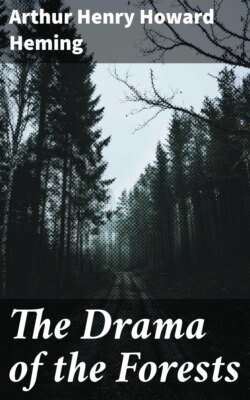Читать книгу The Drama of the Forests - Arthur Henry Howard Heming - Страница 16
На сайте Литреса книга снята с продажи.
THE BEST FUR DISTRICTS
ОглавлениеTable of Contents
While we were at supper a perfect roar of gun shots ran around the bay and on our rushing to the doorway we saw the Inspector's big canoe coming. Up went the flag and more gun shots followed. Then we went down to the landing to meet Inspecting Chief Factor Bell.
After supper the newcomer and the Factor and I sat before the fire and discussed the fur trade. I liked to listen to the old trader, but the Inspector, being the greater traveller of the two, covering every year on the rounds of his regular work thousands upon thousands of miles, was the more interesting talker. Presently, when the subject turned to the distribution of the fur-bearing animals, Mr. Bell took a case from his bag and opening it, spread it out before us upon the Factor's desk. It was a map of the Dominion of Canada, on which the names of the principal posts of the Hudson's Bay Company were printed in red. Across it many irregular lines were drawn in different-coloured inks, and upon its margins were many written notes.
"This map, as you see," remarked the Inspector, "defines approximately the distribution of the fur-bearing animals of Canada, and I'll wager that you have never seen another like it; for if it were not for the records of the Hudson's Bay Company, no such map could have been compiled. How did I manage it? Well, to begin with, you must understand that the Indians invariably trade their winter's catch of fur at the trading post nearest their hunting grounds; so when the[Pg 27] annual returns of all the posts are sent in to the Company's headquarters, those returns accurately define the distribution of the fur-bearing animals for that year. These irregular lines across the map were drawn after an examination of the annual returns from all the posts for the last forty years. Publish it? No, siree, that would never do!"
But the Inspector's remarks did not end the subject, as we began discussing the greatest breeding grounds of the various fur-bearers, and Mr. Bell presently continued:
"The greatest centre for coloured foxes is near Salt River, which flows into Slave River at Fort Smith. There, too, most of the black foxes and silver foxes are trapped. The great otter and fisher centre is around Trout Lake, Island Lake, Sandy Lake, and God's Lake. Otter taken north of Lake Superior are found to be fully one third larger than those killed in any other region. Black bears and brown bears are most frequently to be met with between Fort Pelly and Portage La Loche. Cumberland House is the centre of the greatest breeding grounds for muskrat, mink, and ermine. Manitoba House is another great district for muskrat. Lynxes are found in greatest numbers in the Iroquois Valley, in the foothills on the eastern side of the Rockies. Coyote skins come chiefly from the district between Calgary and Qu'Appelle for a hundred miles both north and south. Skunks are most plentiful just south of Green Lake; formerly, they lived on the plains, but of late they have moved northward into the woods. Wolverines frequent most the timber country just south of the Barren Grounds, where they are often found travelling in bands. The home of the porcupine lies just north of Isle à la Crosse. Forty years ago the breeding grounds of the beaver were on the eastern side of the Rockies. Nowadays that region is hardly worth considering as a trapping ground for them. They have been steadily migrating eastward along the Churchill River, then by way of Cross Lake, Fort Hope, to Abitibi, thence north[Pg 28]easterly clean across the country to Labrador, where few were to be found twenty-five years ago. Don't misunderstand me. I'm not saying that beaver were not found in those parts years ago, but what I mean is that the source of the greatest harvest of beaver skins has moved steadily eastward during the last forty years. Strange to say, the finest marten skins secured in Canada are not those of the extreme northern limit, but those taken on the Parsnip River in British Columbia."
